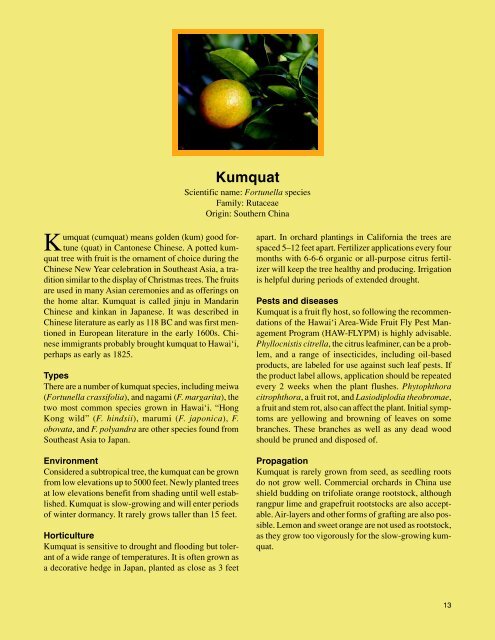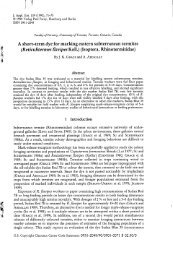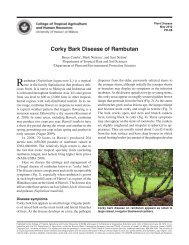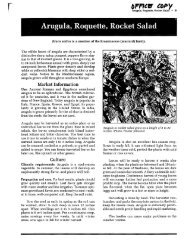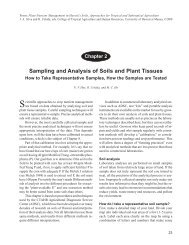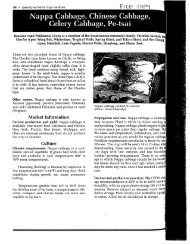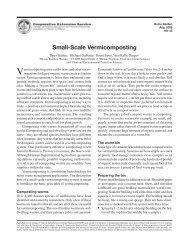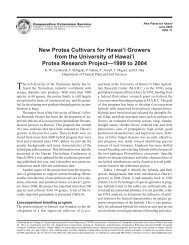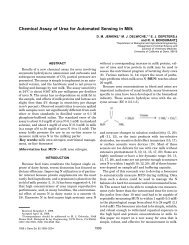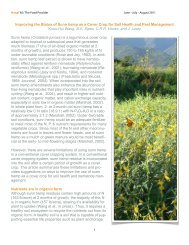You also want an ePaper? Increase the reach of your titles
YUMPU automatically turns print PDFs into web optimized ePapers that Google loves.
<strong>Kumquat</strong> (cumquat) means golden (kum) good fortune<br />
(quat) in Cantonese Chinese. A potted kumquat<br />
tree with fruit is the ornament of choice during the<br />
Chinese New Year celebration in Southeast Asia, a tradition<br />
similar to the display of Christmas trees. The fruits<br />
are used in many Asian ceremonies and as offerings on<br />
the home altar. <strong>Kumquat</strong> is called jinju in Mandarin<br />
Chinese and kinkan in Japanese. It was described in<br />
Chinese literature as early as 118 BC and was first mentioned<br />
in European literature in the early 1600s. Chinese<br />
immigrants probably brought kumquat to Hawai‘i,<br />
perhaps as early as 1825.<br />
Types<br />
There are a number of kumquat species, including meiwa<br />
(Fortunella crassifolia), and nagami (F. margarita), the<br />
two most common species grown in Hawai‘i. “Hong<br />
Kong wild” (F. hindsii), marumi (F. japonica), F.<br />
obovata, and F. polyandra are other species found from<br />
Southeast Asia to Japan.<br />
Environment<br />
Considered a subtropical tree, the kumquat can be grown<br />
from low elevations up to 5000 feet. Newly planted trees<br />
at low elevations benefit from shading until well established.<br />
<strong>Kumquat</strong> is slow-growing and will enter periods<br />
of winter dormancy. It rarely grows taller than 15 feet.<br />
Horticulture<br />
<strong>Kumquat</strong> is sensitive to drought and flooding but tolerant<br />
of a wide range of temperatures. It is often grown as<br />
a decorative hedge in Japan, planted as close as 3 feet<br />
<strong>Kumquat</strong><br />
Scientific name: Fortunella species<br />
Family: Rutaceae<br />
Origin: Southern China<br />
apart. In orchard plantings in California the trees are<br />
spaced 5–<strong>12</strong> feet apart. Fertilizer applications every four<br />
months with 6-6-6 organic or all-purpose citrus fertilizer<br />
will keep the tree healthy and producing. Irrigation<br />
is helpful during periods of extended drought.<br />
Pests and diseases<br />
<strong>Kumquat</strong> is a fruit fly host, so following the recommendations<br />
of the Hawai‘i Area-Wide Fruit Fly Pest Management<br />
Program (HAW-FLYPM) is highly advisable.<br />
Phyllocnistis citrella, the citrus leafminer, can be a problem,<br />
and a range of insecticides, including oil-based<br />
products, are labeled for use against such leaf pests. If<br />
the product label allows, application should be repeated<br />
every 2 weeks when the plant flushes. Phytophthora<br />
citrophthora, a fruit rot, and Lasiodiplodia theobromae,<br />
a fruit and stem rot, also can affect the plant. Initial symptoms<br />
are yellowing and browning of leaves on some<br />
branches. These branches as well as any dead wood<br />
should be pruned and disposed of.<br />
Propagation<br />
<strong>Kumquat</strong> is rarely grown from seed, as seedling roots<br />
do not grow well. Commercial orchards in China use<br />
shield budding on trifoliate orange rootstock, although<br />
rangpur lime and grapefruit rootstocks are also acceptable.<br />
Air-layers and other forms of grafting are also possible.<br />
Lemon and sweet orange are not used as rootstock,<br />
as they grow too vigorously for the slow-growing kumquat.<br />
13
Ripe nagami kumquats Meiwa<br />
Harvesting and yield<br />
Fruits are harvested when fully ripe and orange. Fruits<br />
should be free of defects and inspected carefully for<br />
damage from fruit flies. In Hawai‘i, meiwa kumquat is<br />
sometimes confused with calamansie (Citrus microcarpa),<br />
which bears a small, round, orange-colored lime.<br />
The meiwa fruit has a much thinner skin and much<br />
sweeter taste than the lime. Meiwa also does not fruit as<br />
heavily as calamansie, which often produces large clusters<br />
of limes. China is the largest producer of kumquats,<br />
with more than 18,000 tons harvested yearly.<br />
Postharvest quality<br />
When stored at 36–39°F, kumquats keep well for 1–2<br />
months in commercial produce storage refrigerators, or<br />
about 2–3 weeks in a home refrigerator. Juice and whole<br />
or sliced fruits can be frozen for future use. At room<br />
temperature the fruit will last only a few days. The thinskinned<br />
fruit should be packaged in blister packs no more<br />
than 3 inches deep to prevent compression damage.<br />
Packaging, pricing, and marketing<br />
<strong>Kumquat</strong>s sold in Asia and Hawai‘i are either sold loose,<br />
with or without leaves, or packaged in small blister<br />
packs. Packaged fruits should be free of defects and inspected<br />
for possible fruit fly damage. <strong>Kumquat</strong>s should<br />
be fully ripe and orange when packaged. If sold with<br />
leaves attached, the leaves should be free of insect damage.<br />
In Hawai‘i, kumquats are more commonly found<br />
in farmers’ markets but are occasionally sold in supermarkets<br />
around the New Year holiday. Prices in Hawai‘i<br />
range from $2.50 to $7.00 per pound for both wholesale<br />
and retail. Chefs often request the best quality fruit for<br />
their culinary creations.<br />
14<br />
Nagami<br />
Food uses and nutrition<br />
<strong>Kumquat</strong>s are a good balanced source of vitamins and<br />
antioxidants. Cryptoxanthin, zeaxanthin, and lutein are<br />
essential for eye and vision care. <strong>Kumquat</strong>s are eaten<br />
fresh or made into jams, jellies, and pickles; candied;<br />
and used in a wide variety of recipes.
Nutritional value per 100 g of edible portion*<br />
Water .................................................. 80.85 g<br />
Energy ................................................ 71 kcal<br />
Energy ................................................ 296 kj<br />
Protein ................................................ 1.88 g<br />
Total lipid (fat) ..................................... 0.86 g<br />
Ash ..................................................... 0.52 g<br />
Carbohydrate, by difference ............... 15.90 g<br />
Fiber, total dietary .............................. 6.5 g<br />
Sugars, total ....................................... 9.36 g<br />
Minerals<br />
Calcium, Ca........................................ 62 mg<br />
Iron, Fe ............................................... 0.86 mg<br />
Magnesium, Mg.................................. 20 mg<br />
Phosphorus, P ................................... 19 mg<br />
Potassium, K ...................................... 186 mg<br />
Sodium, Na ........................................ 10 mg<br />
Zinc, Zn .............................................. 0.17 mg<br />
Copper, Cu ......................................... 0.095 mg<br />
Manganese, Mn ................................. 0.135 mg<br />
Vitamins<br />
Vitamin C, total ascorbic acid ............. 43.9 mg<br />
Thiamin .............................................. 0.037 mg<br />
Riboflavin ........................................... 0.090 mg<br />
Niacin ................................................. 0.429 mg<br />
Pantothenic acid ................................ 0.208 mg<br />
Vitamin B6 .......................................... 0.036 mg<br />
Folate, total ........................................ 17 mcg<br />
Folate, food ........................................ 17 mcg<br />
Folate, DFE ........................................ 17 mcg<br />
Vitamin A ............................................ 290 IU<br />
Vitamin A, RAE................................... 15 mcg<br />
Vitamin E (alpha-tocopherol).............. 0.15 mg<br />
Carotene, alpha ................................. 155 mcg<br />
Cryptoxanthin, beta ............................ 193 mcg<br />
Lutein + zeaxanthin ............................ <strong>12</strong>9 mcg<br />
*Values compiled from various sources<br />
8 cups thinly sliced kumquats<br />
1 ⁄2 cup tangerine juice<br />
6 oz pectin<br />
5 1 ⁄2 cups sugar<br />
3 T finely minced fresh ginger<br />
1 tsp (heaping) Chinese 5-spice<br />
<strong>Kumquat</strong> sorbet<br />
<strong>Kumquat</strong> Mongolian beef as served in a restaurant in<br />
Captain Cook, Hawai‘i<br />
Recipe: <strong>Kumquat</strong>, ginger, and Chinese 5-spice marmalade<br />
Chef Paul Heerlein<br />
In a saucepan, combine the kumquat and tangerine juice<br />
and bring to a boil. Slowly add the pectin while whisking,<br />
and then bring to a second boil. Add sugar while whisking<br />
and bring to boil again. Turn off the heat, stir in the ginger<br />
and 5-spice, and bottle immediately. Boil the filled jars for<br />
twenty minutes.<br />
15


